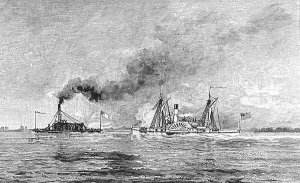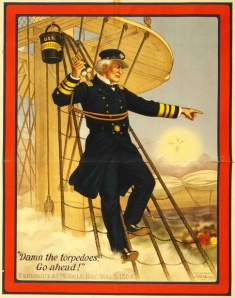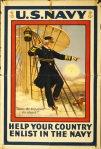We read a small bit about the Battle of Mobile Bay back on August 13, but this is a much fuller description. The following is from the August 27, 1864, issue of The Prescott Journal.
The Attack on Mobile.
Admiral Farragut [David G. Farragut] in a letter to Com. Palmer¹ at New Orleans says :
“At an early hour on the 5th our fleet dashed in in [sic] couples, sailed into the pass close under the guns of Fort Morgan ; pouring in broadside after broadside of grape and cannister [sic], thus driving the gunners from their places, and leaving our vessels exposed only to the fire of Forts Gaines and Powell, which was of course less effective on account of the distance. At the same time Gen. Granger’s [Gordon Granger] land batteries enfiladed Fort Gaines, and caused the evacuation and blowing up of Fort Powell. In passing the fort the Oneida received a shot, which temporarily disabled her machinery, but she was safely towed through the fire by her consort. Our monitor Tecumseh was one of the foremost vessels, and sank almost instantly, carrying down about 100 men, including Capt. Craven. The gunboats having passed out of reach of the forts, were pursued by the formidable rebel ram Tennessee and three iron clads. The ram was immediately attacked, and battered so effectually that it was obliged to surrender in a few minutes. The ram was but slightly injured.
The Herald’s correspondent off Mobile says :

“When the Selma surrendered to the Metacomet, on boarding her it was found that she had lost fearfully. Her deck was covered with dead and dying and her scuppers ran with blood. Her commander, Lt. Comstock,² formerly of the United States navy, was lying dead across the breech of a gun with his bowels torn out. The Tennessee attempted to avoid the Monitors and made for the wooden ships, but the flag ship and the Monongahela followed her up. The latter struck the Tennessee amidship with her terrible prow, causing the huge rebel monster to reel like a drunk man. The Hartford then grappled the Tennessee, but further bloodshed was saved by the latter hoisting the white flag.—Horrible slaughter was visible here as on the Selma. Capt. Garaud [sic]4 now commands the captured ram. We captured nearly three hundred prisoners.”

.
The New Orleans Era says that Admiral Farragut chose a novel position in going into the fight off Mobile, and maintained it throughout all the terrible fighting. Desiring at once to overlook the enemy and watch the movements of his own fleet, he ascended the maintop of the Hartford and was there lashed fast. A speaking-trumpet was run down to the deck, and an officer stationed at the lower end to receive the Admiral’s orders, and pass them to the officer whose duty it was to see them executed. This proved to be a most admirable arrangement.
.
The following official dispatch has been received by the Navy Department.
FLAG SHIP HARTFORD, MOBILE BAY, }
August 5, 1864. }
Hon. Gideon Welles, Secretary of the Navy.
SIR :— I have the honor to report to the Department that this morning I entered Mobile bay, passing between Forts Morgan and Gaines, encountering the rebel ram Tennessee and the gun boats of the enemy viz : the Selma, Morgan and Gaines.
The fleet was under way by 5:45 and in the following order :
The Brooklyn with the Octorara on her port side.
The Hartford with the Metacomet.
The Richmond with the Port Royal.
The Lackawanna with the Seminole.
The Monongahela with the Tecumseh.6
The Ossipee with the Itasca.
The Oneida with the Galena.
On the starboard of the fleet was the proper position of the monitors and iron-clads. Fort Morgan opened upon us at 10 minutes past 7 o’clock, and soon after the action became lively. As we steamed up the main ship-channel, there was some difficulty and the Hartford passed on ahead of the Brooklyn.
At 40 minutes past 7 the monitor Tecumseh was struck by a torpedo and sunk, going down very rapidly and carrying down with her all her officers and crew with the exception of the pilot, and 8 or 10 men who were saved by a boat that I sent from the Metacomet which was alongside of me.
The Hartford had passed the forts before 8 o’clock. Finding myself raked by the rebel gun-boats I ordered the Metacomet to cast off and go in pursuit of them, one of which, the Selma, she succeeded in capturing.
All the vessels had passed the forts by 8:30, but the rebel ram Tennessee was still, apparently uninjured, in our rear. A signal was at once made to all the fleet to turn again and attack the ram, not only with guns, but with orders to run her down at full speed. The Monongahela was the first that struck her, and though she may have injured her badly, yet she did not succeed in disabling her. The Lackawanna also struck her, but in effectually. The flag ship gave her a severe shock with her bow, and as she passed fired into her a whole port broadside of solid 9-inch shot and 13 pounds of powder at a distance of not more than 12 feet. The ironclads were closing upon her and the Hartford and the rest of the fleet were bearing down upon her when at 10 a. m. she surrendered. The rest of the rebel fleet, viz : Morgan and Gaines, succeeded in getting back under the protection of Fort Morgan. This terminated the action of the day.
Admiral Buchanan [Franklin Buchanan] sent me his sword, being himself badly wounded with a compound fracture of the leg, which it is supposed will have to be amputated. Having had many of my own men wounded and the surgeon of the ram Tennessee being very desirous to have Admiral Buchanan removed to a hospital, I sent a flag of truce to the commanding officer of Fort Morgan, Brig. Gen. R. L. Page,7 to say that if he would allow the wounded of the fleet as well as their own to be taken to Pensacola, where they could be better cared for than here, I would send out one of our vessels, provided she would be permitted to return bringing back nothing that she did not take out. Gen. Page consented, and the Metacomet was dispatched.
The total loss on our side was 40 killed and 88 wounded. On the rebel ram Tennessee were captured 20 officers and about 170 men ; on the Selma were taken 90 officers and men. I will send a detailed dispatch by the first opportunity.
. .Very respectfully,
. .D. G. FARRAGUT,
Rear Admiral Commanding West Gulf Blockading Squadron.
1. James Shedden Palmer (1810-1867) entered the U.S. Navy at 14 as Ship’s Boy and became a midshipman less than six months later. In 1836 he was promoted to lieutenant. He commanded the Flirt during the Mexican War and became a commander in 1855. During the Civil War Palmer commanded the Iroquois and the Hartford. He was promoted to captain in July 1862 and commodore in February 1863. He commanded the Naval Station at New Orleans and the West Gulf Squadron during 1864. In 1865 he was given command of the West Indies Squadron. On July 25, 1866 Palmer became a rear admiral.
2. John Henry Comstock (1840-1864) was the executive officer of the CSS Selma. He was born May 24, 1840, in Clinton, Louisiana. He had been attending the U.S. Naval Academy since at least 1858, where he was an acting midshipman; he resigned on January 30, 1861. In May 1861 Comstock enlisted in the Confederate Navy and was a midshipman, serving on the CSS McRae. Next he commanded the CSRS St. Philip (1861-1862). In October 1862 Comstock was promoted to 2nd lieutenant. Also in 1862 he moved to the CSS Florida—renamed CSS Selma in July 1862—and then to the CS steamers Morgan and Gaines in the Mobile Squadron (1862-1863). On June 2, 1864, he was promoted to 1st lieutenant, with rank from January 6. In 1864 Comstock was serving on the CSS Selma in the Mobile Squadron, where he died on August 5.
3. Engraving of the USS Metacomet capturing the CSS Selma, by Winham, “from a War-time sketch,” published in Battles and Leaders of the Civil War, edited by R.U. Johnson and C.C. Clough Buel (New York: Century Co., 1887-88): vol. 4, page 394; available in the UWRF Chalmer Davee Library, E470 .B346. Image is available digitally on the U.S. Naval Historical Center, Photograph #NH 42219.
4. Acting Volunteer Lieutenant Pierre Giraud joined the navy as acting master in August 1861 and was the executive officer aboard the U.S.S. Morning Light, which was engaged in patrolling the eastern approaches for vessels suspected of running contraband cargo into Southern ports. Later, as part of the Savannah blockade, Giraud was serving under Captain Worden on the USS Montauk in February 1863 when the warship cornered the legendary CSS Nashville and destroyed the Confederate vessel within minutes of opening fire. Giraud had commanded the 11-inch battery of the Montauk. Giraud was then promoted to acting lieutenant on August 5, 1863. He was also cited for “gallant conduct” during the April attack on Fort Sumter in which Montauk was a part.
In November 1863 Giraud assumed command of the USS Tennessee, a former Confederate side wheel steamer captured by Farragut at New Orleans, and during the spring of 1864 the USS Tennessee cruised the Gulf of Mexico looking for blockade runners. Giraud then joined the crew of the eight-gun steamer USS Ossipee as a volunteer. At the Battle of Mobile, Giraud found himself at the center of the action when the Ossipee was signaled to ram the crippled CSS Tennessee. Immobile, unable return fire, and with Admiral Buchanan wounded, the CSS Tennessee struck her colors prepared to surrender. Amidst the smoke and chaos Tennessee was rammed and boarded by Giraud. Afterwards, the Tennessee was refitted and temporary command given to Giraud.
In October 1864 Giraud took charge of the USS Mobile, the ex-USS Tennessee renamed, and promptly set about capturing several blockade runners. The worn out USS Mobile was then ordered to New York for repairs following storm damage. In New York Giraud received the acclaim of Admiral Farragut who wrote in glowing terms to Secretary Welles of the officer’s deportment and conduct. Giraud was promoted to Acting Volunteer Lieutenant-Commander on December 9, 1864, but was destined to see no further active service. He remained in command of the Mobile until she was sold out of service in March 1865 and was then assigned to the three-gun sailing vessel USS Onward. Pierre Giraud was honorably discharged on January 15, 1869.
 5. This is the central image from a World War I recruitment poster of the U.S. Navy showing Admiral Farragut lashed at the top of the Hartford. It was drawn by Henry Alexander Ogden and published by the Strobridge Litho. Co., Cincinnati & New York, c1917. The image is from the Library of Congress, Prints and Photographs Division.
5. This is the central image from a World War I recruitment poster of the U.S. Navy showing Admiral Farragut lashed at the top of the Hartford. It was drawn by Henry Alexander Ogden and published by the Strobridge Litho. Co., Cincinnati & New York, c1917. The image is from the Library of Congress, Prints and Photographs Division.
6. This should be the Monongahela with the Kennebec. Not mentioned in Farragut’s list is the van of monitors led by the Tecumseh, also including the Manhattan, Winnebago, and Chickawaw. Altogether, there were 18 U.S. ships that day.
7. Richard Lucian Page (1807-1901) was a cousin of Confederate General Robert E. Lee. Page joined the U.S. Navy as a midshipman in March 1824. he was promoted to Commander in 1855 and commanded the USS Germantown from 1857 to 1859. When Virginia seceded in 1861, he resigned from the Navy and became an aide to Virginia Governor John Letcher, supervising construction of fortifications on the James, Nansemond, and Pagan Rivers. He received commissions in the Confederate Navy as commander, and later captain. In 1864, Page was commissioned a brigadier general in the Confederate Army and was in command of the garrison that controlled Fort Morgan during the Union’s attack on Mobile Bay. On August 23 General Page unconditionally surrendered the fort, because his troops had little usable gunpowder. Indignant, he broke his sword over his knee instead of surrendering it. He was held prisoner until September 1865. After the War, Page was superintendent of Norfolk public schools (1875 to 1883).